
The Tillamook County Creamery Association (TCCA) is a farmer-owned dairy cooperative headquartered in Tillamook County, Oregon, United States. The association manufactures and sells dairy products under the "Tillamook" brand name. Its main facility is the Tillamook Creamery, located two miles north of the city of Tillamook on U.S. Route 101.
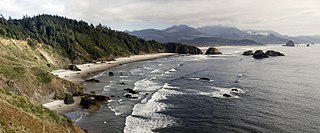
The Oregon Coast is a coastal region of the U.S. state of Oregon. It is bordered by the Pacific Ocean to its west and the Oregon Coast Range to the east, and stretches approximately 362 miles (583 km) from the California state border in the south to the Columbia River in the north. The region is not a specific geological, environmental, or political entity, and includes the Columbia River Estuary.
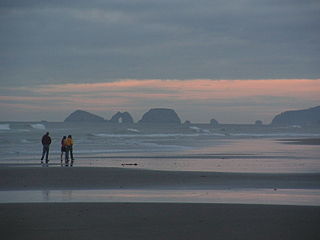
Cape Lookout is a sharp rocky promontory along the Pacific Ocean coast of northwestern Oregon in the United States. It is located in southwestern Tillamook County, approximately 10 miles (16 km) southwest of Tillamook, just south of Netarts Bay. The promontory extends 1.5 miles (2.4 km) perpendicular to the coast, and is approximately 0.5 miles (0.80 km) wide at its base, tapering as it extends outward from the coast. Cape Lookout State Park is located on the north side of the promontory, which is part of the Siuslaw National Forest. Cape Lookout Road travels past the base of the cape. Cape Lookout is a member of Tillamook's Three Capes Scenic Drive.
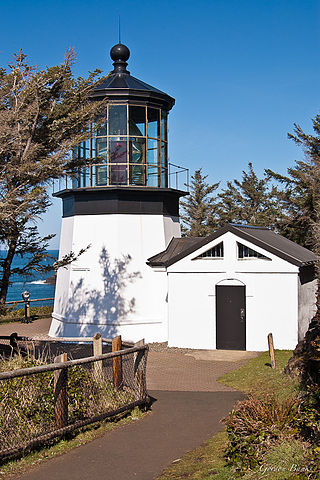
The Cape Meares Light is an inactive lighthouse on the coast of Oregon. It is located on Cape Meares just south of Tillamook Bay. It is open to the public.
Cape Meares is a small headland on the Pacific coast in Tillamook County, Oregon, United States. The cape forms a high steep bluff on the south end of Tillamook Bay, approximately five miles (8 km) northwest of the city of Tillamook. Much of the cape is part of the Oregon Parks and Recreation Department-administered Cape Meares State Scenic Viewpoint with three miles of hiking trails, which includes Cape Meares Light and the Octopus Tree. The cape is named after John Meares, a British explorer.
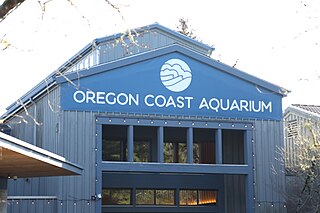
The Oregon Coast Aquarium is an aquarium in Newport in the U.S. state of Oregon. Opened in 1992, the facility sits on 23 acres (9.3 ha) along Yaquina Bay near the Pacific Ocean. The aquarium was home to Keiko, the orca who starred in the movie Free Willy, from January 7, 1996, until September 9, 1998, when he was shipped to Vestmannaeyjar, Iceland. USA Today considers the Oregon Coast Aquarium world-class and Coastal Living magazine ranks it among the top ten aquariums in North America.

U.S. Route 101 (US 101), is a major north–south U.S. Highway in Oregon that runs through the state along the western Oregon coastline near the Pacific Ocean. It runs from the California border, south of Brookings, to the Washington state line on the Columbia River, between Astoria, Oregon, and Megler, Washington.
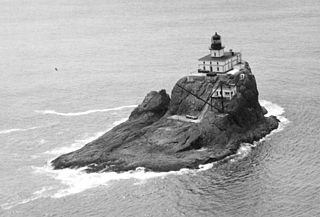
Tillamook Rock Light is a deactivated lighthouse on the northern Oregon Coast of the United States. It is located approximately 1.2 miles (1.9 km) offshore from Tillamook Head, and 20 miles (32 km) south of the mouth of the Columbia River near Astoria, situated on less than an acre of basalt rock in the Pacific Ocean. The construction of the lighthouse was commissioned in 1878 by the United States Congress and took more than 500 days to complete. Shortly before the completion of the lighthouse in January 1881, the barque Lupatia was wrecked near the rock during foggy weather and sank, with the loss of all 16 crew members.

Madras Municipal Airport, formerly City-County Airport, is a public use airport located three nautical miles (6 km) northwest of the central business district of Madras, a city in Jefferson County, Oregon, United States. According to the FAA's National Plan of Integrated Airport Systems for 2009–2013, it is classified as a general aviation airport.
The Oregon Coast National Wildlife Refuge Complex consists of six National Wildlife Refuges along the Oregon Coast. It provides wilderness protection to thousands of small islands, rocks, reefs, headlands, marshes, and bays totaling 371 acres spanning 320 miles (515 km) of Oregon's coastline. The areas are all managed by the United States Fish and Wildlife Service.
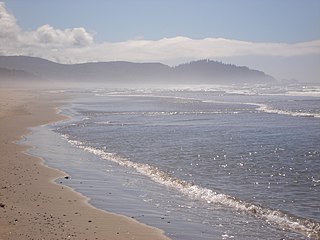
Cape Meares National Wildlife Refuge is a National Wildlife Refuge of the Oregon Coast. It is one of six National Wildlife Refuges in the Oregon Coast National Wildlife Refuge Complex. Located on Cape Meares, the refuge was established in 1938 to protect a remnant of coastal old-growth forest and the surrounding habitat used by breeding seabirds. The area provides a home for a threatened bird species, the marbled murrelets. Peregrine falcons, once at the brink of extinction, have nested here since 1987. The refuge, with the exception of the Oregon Coast Trail, was designated a Research Natural Area in 1987.

The Great Coastal Storm of 2007 was a series of three powerful Pacific storms that affected the U.S. states of Oregon and Washington and the Canadian province of British Columbia between December 1, 2007 and December 4, 2007.

Proposal Rock is an island off the coast of the U.S. state of Oregon, in Tillamook County, near the community of Neskowin. The island is named for a local legend of a sea captain taking his beloved there to propose to her. The proposal was from Charley Gage to Della Page sometime around 1900. Della's mother, Sarah, then dubbed it Proposal Rock to mark the occasion.
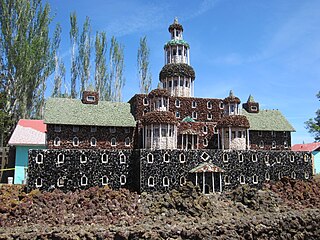
Petersen Rock Garden, formerly Petersen's Rock Garden and also known as the Petersen Rock Gardens, is a rock garden and museum on 4 acres (1.6 ha), located between the cities of Bend and Redmond in Deschutes County, Oregon, United States. Rasmus Petersen, a Danish immigrant who settled in Central Oregon in the early 1900s, began constructing the garden in 1935 using rocks he found within an 85-mile (137 km) radius of his family home. Petersen constructed detailed miniature castles, churches and other small buildings and monuments from a variety of rock types. He incorporated other design elements such as bridges, water features, and natural landscaping. Petersen worked on the garden until his death in 1952; the garden has remained in his family's care since then. The garden, considered a roadside attraction with novelty architecture, includes roaming peafowl and a museum with a gift shop that sells rocks.

Camp Meriwether is a 790-acre Scouts BSA summer camp founded in 1926 and located south of Cape Lookout near Cloverdale, Oregon, along the Oregon Coast. Camp Meriwether is the largest of the Cascade Pacific Council's four resident camps in Oregon. During World War II, the camp was closed for two years and served as a US Army outpost until 1943. Since 2015, there has been controversy over the intended development of a golf course over 200 acres of coastal land.

The Pine Grove Community House in Manzanita, Oregon, United States, was completed in 1933 and added to the National Register of Historic Places on July 3, 2017.
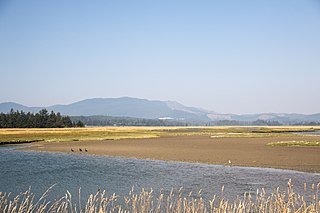
Sitka Sedge State Natural Area is an estuary and beach on the north coast of the U.S. state of Oregon in Tillamook County. Sitka Sedge consists of 357 acres (144 ha) of tidal marsh, mudflats, dunes, forested wetlands, and uplands at the south end of the Sand Lake estuary, north of Tierra Del Mar.

Greek Cusina was a Greek restaurant with two locations in the Portland metropolitan area, in the United States. The restaurants were located in downtown Portland and Tualatin. Both closed in 2010.

Gracie's Sea Hag is a seafood restaurant in Depoe Bay, Oregon, United States.

Many coastal peninsulas of Oregon are properly headlands, often called capes.



















